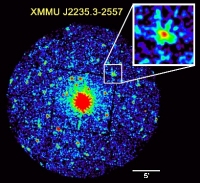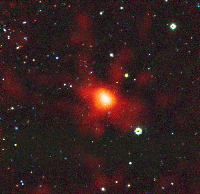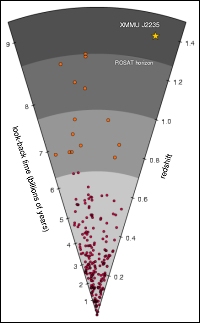Distant Galaxies Show a Young Universe
2 March 2005
Using ESA's X-ray observatory XMM-Newton and the European Southern Observatory's Very Large Telescope, scientists have discovered the most distant massive structure in the Universe. The data reveal a cluster of hundreds of galaxies already in place when the Universe was only a third of its present age. This discovery suggests that the Universe's hierarchal structure of stars, galaxies and clusters formed quickly after the big bang, much earlier than astronomers thought.Although our galaxy, the Milky Way, lies in a relatively sparse neighbourhood, there are regions in space where galaxies are crowded together in much larger numbers. Known as galaxy clusters, these structures consist of hundreds or even thousands of galaxies held together by their gravitational pull and make up the fabric of the Universe.
 |
|
The XMM-Newton observation of the nearby galaxy NGC 7314 (bright object at center) from which the distant cluster XMMU J2235.3-2557 was serendipitously identified (white box). |
Much to the astonishment of the astronomers, however, this cluster appears to be well developed and mature, in spite of its relative youth. This indicates that the stars and galaxies in it formed and assembled into a cluster quite early in the life of the Universe.
"We are quite surprised to see that an exquisite structure like this could exist at such early epochs," said Dr Christopher Mullis, University of Michigan, USA, who lead an international team of scientists in this research. "We see an entire network of stars and galaxies in place at just a few thousand million years after the big bang, as if a kingdom popped up overnight," Mullis explained.
This discovery calls for a reconsideration of current theories, since until recently astronomers believed that structures like this did not even exist at such early epochs. "We have underestimated how quickly the early Universe matured into its present-day incarnation," said Dr Piero Rosati, of the European Southern Observatory, Garching, Germany, and a member of the team. "It is now clear that the Universe grew up fast."
The scientists said that this discovery might be just the tip of the iceberg. Their results are based on a first peek at archived XMM-Newton data from the past four years. Additional faint and distant galaxy clusters might be captured in the data archive.
XMM-Newton gives scientists a formidable tool to search for galaxy clusters because most of their ordinary matter takes the form of hot, tenuous gas in between galaxies that is invisible to optical telescopes and can only be detected with large, orbiting X-ray observatories. Mullis said that a 12 hour long XMM-Newton observation of a nearby galaxy revealed tantalising evidence of a galaxy cluster far in the background. Knowing where to look, his team used the powerful European Southern Observatory’s Very Large Telescope (VLT) in the Atacama Desert in Chile to find an optical counterpart.
Sure enough, the team found dozens of galaxies associated with this X-ray emission. The VLT data established the distance to the cluster to be about 9000 million light years. The galaxies were reddish, elliptical types, an indication that they were already several billion years old and filled with older red stars. The cluster itself was largely spherical, a sign that it was well formed.
Proto-clusters, namely clusters in the making, have been seen at distances of over 10 000 million light years. The new finding is the best evidence yet of when these wild proto-clusters reached maturity. The relative ease of discovery, based on archived data, implies that the team could build a large sample size of exceedingly distant clusters. This would allow scientists to directly test competing theories of structure formation and evolution. The team is currently pursuing detailed follow-up observations from both ground and space-based observatories.
Notes for editors
The results of this research is the subject of an article entitled Discovery of an X-ray-Luminous Galaxy Cluster at z=1.4 that will appear in an upcoming issue of the Astrophysical Journal. Besides C. Mullis, the author list includes P. Rosati, G. Lamer, H. Boehringer, A. Schwope, P. Schuecker and R. Fassbender.
A preprint of the article can be found by following the link under Related Links on the right side navigation.
More about XMM-Newton
ESA's XMM-Newton can detect more X-ray sources than any previous satellite and is helping to solve many cosmic mysteries of the violent Universe, from black holes to the formation of galaxies. It was launched on 10 December 1999, using an Ariane-5 rocket, from French Guiana. It is expected to return data for a decade. XMM-Newton's high-tech design uses over 170 wafer-thin cylindrical mirrors spread over three telescopes. Its orbit takes it almost a third of the way to the Moon, so that astronomers can enjoy long, uninterrupted views of celestial objects.
For more information about XMM-Newton please see:
http://www.esa.int/esaSC/spk.html
For further details please contact
Dr Christopher Mullis
University of Michigan
Ann Harbor, USA
Tel: +1 734 615 7374
E-mail: cmullis umich.edu
umich.edu
Dr Piero Rosati
European Southern Observatory
Garching, Germany
Tel: +49 89 3200 6539
E-mail: prosati eso.org
eso.org
Dr Norbert Schartel
ESA XMM-Newton Project Scientist
European Space Astronomy Centre
Villafranca del Castillo, Spain
Tel: +34 91 813 1184
E-mail: norbert.schartel sciops.esa.int
sciops.esa.int



